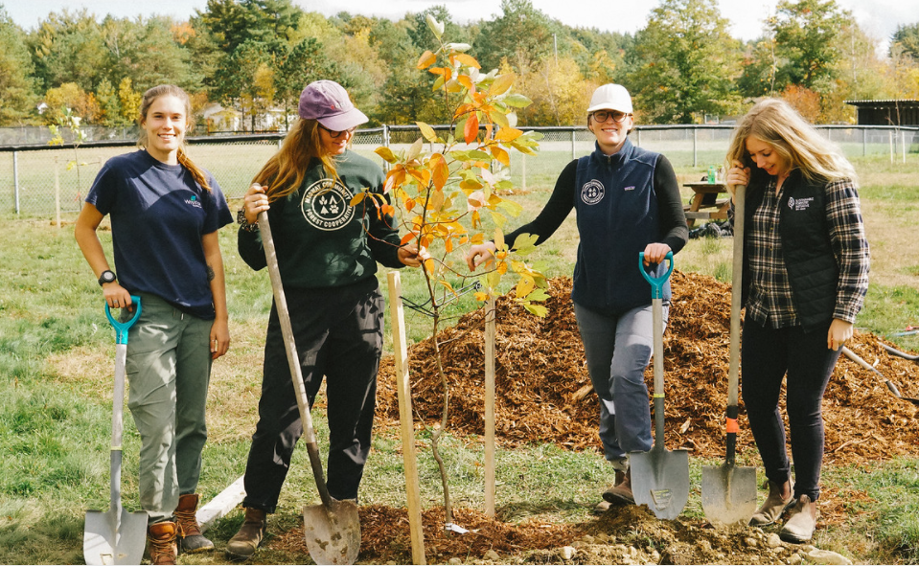I’ve always loved being in the woods, but I didn’t realize that forestry was a viable career path for me until my early twenties. When I was growing up, I had limited opportunities to explore environmental jobs and lacked female mentors in the sector. So, as the Geographic Information System (GIS) and Conservation Research Coordinator at the Sustainable Forestry Initiative and a woman in science, I know it can be daunting to envision yourself working in a traditionally male-dominated industry. That’s part of the reason why it’s so important to me that young students see more representations of women and girls in science.
I’m proud to work for the SFI, a woman-led non-profit organization that advances sustainability through forest-focused collaboration including through supporting environmental education and community greening efforts. Learning about the environment and how to take care of it is more important than ever! Amid the climate challenge and population increases, even greater pressure will be put on our natural resources in the future, requiring the next generations to make better choices for both people and the planet.

They invited me to attend their upcoming tree-planting workshop (supported by a recent SFI Community Grant) to get students at North Queens Community School excited about climate-adaptive forestry. The workshop’s goal to show younger generations how they can be environmental advocates and take local action is an issue that’s important to me and something that I am especially proud to represent for future generations of girls interested in forestry, GIS, and conservation science. An opportunity to meet other women and girls with these interests and we’ll plant climate-adaptive trees? Sounds like my kind of fun!
I also hoped that by joining the tree-planting workshop, I could help encourage more girls to follow their aspirations with confidence.
February 11 is the International Day of Women and Girls in Science.
The United Nations declared this annual holiday because of the gender gap that still exists in the fields of science, technology, engineering, and mathematics (STEM).
THE BENEFITS OF ENVIRONMENTAL EDUCATION
I only remember taking one environmental field trip the whole time I was in school. It was a visit to a Ducks Unlimited site in Halifax, where we did a geocaching activity in the woods at a local park (a treasure hunt for hidden objects using GPS). It wasn’t quite as fun as planting trees, but it definitely contributed to my overall liking for all things forests! However, I can’t help but think that I may have found my passion sooner if I had seen more women represented and experienced more opportunities to explore environmental jobs as a student.
I found it inspiring to see the dedication of the science teachers at North Queens Community School and found myself envious of their students. The school’s educators were clearly committed to giving their students opportunities to really immerse themselves in learning about and in their environment, as this event was only one example of the exciting field trips they’d been on recently. And it was obviously working, because some students spoke of their aspirations to follow in the forestry footsteps of their parents and grandparents! You could tell the students really looked up to their teachers, and the teachers absolutely beamed when talking about their students.
COMMUNITY GREENING AND CLIMATE ACTION
Medway Community Forest Cooperative’s mission is to support local communities through sustainable and ecologically based forest management. The 15,000 hectare/37,000 acre community forest on Crown land in Annapolis County, Nova Scotia, is grounded in cooperation and managed to maximize multiple economic, social, and environmental values. The forest is also managed to fully consider the larger landscape, including protected areas and areas with high conservation values.
Medway and the Mersey Tobeatic Research Institute organized the event with support from SFI’s Community Grant Program and Tree Canada’s Operation Releaf Program, along with other local partners. The workshop educated youth about climate-adaptive forestry by engaging them in community greening and climate action in the rural community of Caledonia, Nova Scotia. Students of all ages from the North Queens Community School planted climate-adaptive hardwood trees throughout the village of Caledonia to add shade, resiliency, and colour to the community.
Mary Jane and Jennika from Medway and Colin Gray from the Mersey Tobeatic Research Institute led the education, training, and tree planting efforts for the student workshop. Spencer Coulstring from WestFor Management Inc. and I joined to support the students as they learned how to plant, helped to manage the supplies we needed, and spoke to students about the connection between forests and climate change.

While the students went back inside to class, we drilled holes in the stakes (donated by Conway Workshop), loaded young trees into trucks, and prepared the supplies for the community tree planting. Then, with help from teachers and volunteers, we transported about 25 grade seven students to Harmony Park for a crash course on planting trees. With excavation from by R & C Weare Logging and mulch donated by Freeman Lumber, students loosened the tree roots and carefully planted the saplings with two stakes on either side, using ties to stabilize the trunk to ensure it doesn’t experience wind stress in its first few years of life.
We finished the work and admired what would one day appear as a small forest surrounding the baseball field, and then headed back to the school to meet a new class of grade nine students ready to learn about tree planting. They helped us plant the remainder of the trees around the North Queens Community School grounds.
CLIMATE SMART FORESTRY

Nova Scotia is part of the Acadian Forest transition zone (between the northern Boreal Forest and southern hardwood forests) and home to a wide variety of tree species. As climate change begins to take hold, the cool conditions preferred by the Boreal coniferous species (spruce, fir, and pine) will begin to deteriorate.
Forest managers are beginning to plant more native species that are adaptable to a warmer climate—and even some non-native species that are projected to have their ranges expand into Nova Scotia in the coming years. This is a consideration that forest managers, both rural and urban, have had to incorporate into their forest management planning as we prepare for the impacts of climate change. The 2022 SFI Forest Management Standard requires that certified organizations periodically update their forest inventory and account for changes in growth due to climate change with the new Climate Smart Forestry Objective.
STUDENT SUCCESSES
The students were really engaged throughout the event. And there were a few young people from each class that especially stood out as leaders. These students were attentive during the lesson on climate change, confident in their physical ability, and inspired participation from others that were more nervous to get involved. Overall, everyone seemed passionate about the purpose of this event and performed their tasks carefully and efficiently. The trees went into the ground faster than I expected! I even overheard one group talking about bringing their future children back to Harmony Park to see how the trees they planted had grown over the years.
This event also required strong community engagement to make it a success, and there was significant in-kind support from a variety of local businesses, providing resources, equipment, and volunteer hours. There was also a strong sense of community within the school–you could tell that the teachers and school volunteers were ecstatic that the students had the opportunity to participate in climate action in their own community, and the students were grateful for the opportunity.

To celebrate the students’ work, the Medway Community Forest Co-Op will be holding a Climate-Adaptive Arboretum grand opening at Harmony Park in spring 2022.
Carley Archibald
GIS and Conservation Research Coordinator
Sustainable Forestry Initiative (SFI)
